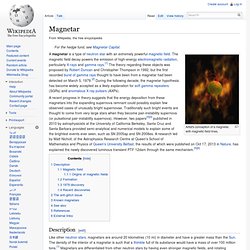

Planetarium. 3D Solar System Web. Magnetar. Artist's conception of a magnetar, with magnetic field lines.

Description[edit] Like other neutron stars, magnetars are around 20 kilometres (10 mi) in diameter and have a greater mass than the Sun. The density of the interior of a magnetar is such that a thimble full of its substance would have a mass of over 100 million tons.[1] Magnetars are differentiated from other neutron stars by having even stronger magnetic fields, and rotating comparatively slowly, with most magnetars completing a rotation once every one to ten seconds,[7] compared to less than one second for a typical neutron star.
This magnetic field gives rise to very strong and characteristic bursts of X-rays and gamma rays. The active life of a magnetar is short. Magnetic field[edit] As described in the February 2003 Scientific American cover story, remarkable things happen within a magnetic field of magnetar strength. Luyten's Star. Luyten's Star (GJ 273) is a red dwarf in the constellation Canis Minor located at a distance of approximately 12.36 light-years (3.79 parsecs) from the Sun.

It has a visual magnitude of 9.9, making it too faint to be viewed with the unaided eye. It is named after Willem Jacob Luyten, who, in collaboration with Edwin G. Ebbighausen, first determined its high proper motion in 1935.[7] WOH G64. WOH G64[3] is a red hypergiant star in the southern constellation of Dorado in the neighboring galaxy Large Magellanic Cloud, 168,000 light years away from Earth.

It is one of the largest known stars, with the radius 1,540 times that of the Sun,[4] or about 1.07 billion kilometres (7.14 AU), corresponding to a volume some 3.65 billion times bigger than the Sun. If placed at the center of the Solar System, the star's surface can engulf Jupiter. Characteristics[edit] Being one of the most luminous cool hypergiant stars in the LMC, WOH G64 exhibits all of the characteristics of a hypergiant. Mu Cephei. Coordinates: History[edit] The deep red color of Mu Cephei was noted by William Herschel, who described it as "a very fine deep garnet colour, such as the periodical star ο Ceti",[10] and it was called Garnet sidus by Giuseppe Piazzi in his catalogue.[11] Later, it is thus commonly known as Herschel's "Garnet Star".[12] An alternative name, Erakis, used in Antonín Bečvář's star catalogue, is probably due to confusion with Mu Draconis, which was previously called al-Rāqis [arˈraːqis] in Arabic.[13] In 1848, English astronomer John Russell Hind discovered that it was variable.

This variability was quickly confirmed by German astronomer Friedrich Wilhelm Argelander. Almost continual records of the star's variability have been maintained since 1881.[14] VY Canis Majoris. VY Canis Majoris (VY CMa) is a red hypergiant in the constellation Canis Major.

It is one of the largest known stars by radius and also one of the most luminous of its type. It is approximately 1,420 ± 120 solar radii[8] (equal to 6.6 astronomical units, thus a diameter about 1,975,000,000 kilometres (1.227×109 mi)), and about 1.2 kiloparsecs (3,900 light-years) distant from Earth. VY CMa is a single star categorized as a semiregular variable and has an estimated period of 2,000 days. It has an average density of 5 to 10 mg/m3. VV Cephei. V354 Cephei. V354 Cephei is a red supergiant star located within the Milky Way.

It is an irregular variable located approximately 9,000 light-years away from our Sun, and is currently considered one of the largest known stars, with a radius estimate of 690-1,520 times that of the Sun, or 1,060,000,000 km at its greatest extent.[5] Assuming the upper size estimate is correct, if it were placed in the center of our Solar System, it would extend to 7 AU, between the orbits of Jupiter and Saturn. See also[edit] References[edit] ^ Jump up to: a b c d V* V354 Cep -- Pulsating variable Star, database entry, SIMBAD. Accessed on line November 12, 2010.^ Jump up to: a b V354 Cep, database entry, The combined table of GCVS Vols I-III and NL 67-78 with improved coordinates, General Catalogue of Variable Stars, Sternberg Astronomical Institute, Moscow, Russia. Vega. Vega (α Lyr, α Lyrae, Alpha Lyrae) is the brightest star in the constellation Lyra, the fifth brightest star in the night sky and the second brightest star in the northern celestial hemisphere, after Arcturus.

It is a relatively close star at only 25 light-years from Earth, and, together with Arcturus and Sirius, one of the most luminous stars in the Sun's neighborhood. Vega is only about a tenth of the age of the Sun, but since it is 2.1 times as massive its expected lifetime is also one tenth of that of the Sun; both stars are at present approaching the midpoint of their life expectancies. Vega has an unusually low abundance of the elements with a higher atomic number than that of helium.[8] Vega is also a suspected variable star that may vary slightly in magnitude in a periodic manner.[13] It is rotating rapidly with a velocity of 274 km/s at the equator. Based on an observed excess emission of infrared radiation, Vega appears to have a circumstellar disk of dust. Altair. Arcturus. Arcturus is a type K1.5 IIIpe orange giant star, with an absolute magnitude of −0.30.

It has likely exhausted its hydrogen from the core and is currently in its active hydrogen shell burning phase. It will continue to expand before entering horizontal branch stage of its life cycle. Aldebaran. In 1997 a substellar companion was reported but subsequent observations have not confirmed this claim.

Physical properties[edit] Size comparison between Aldebaran and the Sun Aldebaran is classified as a type K5III star. Antares. Antares, (/ænˈtɑːriːz/) also known by its Bayer designation Alpha Scorpii (abbreviated to α Scorpii or α Sco), is the seventeenth brightest star in the nighttime sky[a] and the brightest star in the constellation Scorpius, and is often referred to as "the heart of the scorpion".

Alpha Centauri. Location of Alpha Centauri in Centaurus (right-click on starmap to enlarge) From Earth to Alpha Centauri. Alpha Centauri (α Centauri, α Cen; also known as Rigil Kent /ˈraɪdʒəl ˈkɛnt/—see Names) is the brightest star in the southern constellation of Centaurus, and the third brightest star in the night sky.[10][11] The Alpha Centauri system is located 1.34 parsecs or 4.37 light years from the Sun, making it the closest star system to the Solar System.[12] Although it appears to the unaided eye as a single object, Alpha Centauri is actually a binary star system (designated Alpha Centauri AB or α Cen AB) whose combined visual magnitude of −0.27 makes it the third brightest star (other than the Sun) seen from Earth after the −1.46 magnitude Sirius and the −0.72 magnitude Canopus.
Its component stars are named Alpha Centauri A (α Cen A), with 110% of the mass and 151.9% the luminosity of the Sun, and Alpha Centauri B (α Cen B), at 90.7% of the Sun's mass and 44.5% of its luminosity. Betelgeuse. Coordinates: 05h 55m 10.3053s, +07° 24′ 25.426″ The star is classified as a red supergiant of spectral type M2Iab and is one of the largest and most luminous observable stars. If Betelgeuse were at the center of the Solar System, its surface would extend past the asteroid belt, possibly to the orbit of Jupiter and beyond, wholly engulfing Mercury, Venus, Earth and Mars.
Estimates of its mass are poorly constrained, but range from 5 to 30 times that of the Sun. Its distance from Earth was estimated in 2008 at 640 light-years, yielding a mean absolute magnitude of about −6.02. Capella (star) Deneb. Other names include Arided and Aridif, but these have fallen out of use. Visibility[edit] Distance and physical properties[edit] Deneb's absolute magnitude is currently estimated as −8.4, placing it among the most luminous stars known, with an estimated luminosity nearly 200,000 times that of our Sun.[4] This is towards the upper end of various published values over the last few decades.[7][8][9] Deneb's exact distance from the Earth is still rather uncertain.
Regulus. Observations[edit] An occultation of Regulus by the asteroid 166 Rhodope was observed by 12 observers from Portugal, Spain, Italy, and Greece on 2005-10-19. Details are at. Rigel. Although Rigel has the Bayer designation "beta", it is almost always brighter than Alpha Orionis (Betelgeuse). Epsilon Pegasi. Gliese 229. Gamma Crucis. Galactic coordinate system. Sirius. Sirius appears bright because of both its intrinsic luminosity and its proximity to Earth. At a distance of 2.6 parsecs (8.6 ly), as determined by the Hipparcos astrometry satellite,[5][19][20] the Sirius system is one of Earth's near neighbors.
S Doradus. Scale of Universe - Interactive Scale of the Universe Tool. Sun. Procyon. Polaris. Pollux (star) Pillars of Creation. Planetary Nebula M2-9. KY Cygni. Kapteyn's Star.